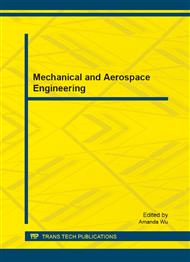[1]
Z. Alkurdi, Y. Dweiri: A biomechanical assessment of isometric handgrip force and fatigue at different anatomical positions. J. Appl. Biomech, Vol. 26 (2010), pp.123-133.
DOI: 10.1123/jab.26.2.123
Google Scholar
[2]
B. Lowe, A. Freivalds: Effect of carpal tunnel syndrome on grip force coordination on hand tools. Ergonomics, Vol. 42 (1999), pp.550-564.
DOI: 10.1080/001401399185469
Google Scholar
[3]
E. Pennestrı, R. Stefanelli: Virtual musculo-skeletal model for the biomechanical analysis of the upper limb. J. Biomech, Vol. 40 (2007), pp.1350-1361.
DOI: 10.1016/j.jbiomech.2006.05.013
Google Scholar
[4]
J. Fisk, J. Wayne: Development and Validation of a Computational Musculoskeletal Model of the Elbow and Forearm. Ann. Biomed. Eng, Vol. 37 (2009), pp.803-812.
DOI: 10.1007/s10439-009-9637-x
Google Scholar
[5]
J. Chalfoun, R. Younes and F. Ben-Ouezdou: Physiological Muscle Forces, Activation and DisplacementPrediction During Free Movement in the Hand and Forearm. J. Robotic. Sys, Vol. 22, pp.653-660.
DOI: 10.1002/rob.20090
Google Scholar
[6]
N. Seo, T. Armsrtong: Investigation of grip force, normal force, contact area, hand size and handle size for cylindrical handles. Hum. Factors, Vol. 50 (2008), pp.734-744.
DOI: 10.1518/001872008x354192
Google Scholar
[7]
N. Seo, T. Armsrtong, J. Ashton-Miller and D. Chaffin: The effect of torque direction and cylindrical handle diameter on coupling between the hand and a cylindrical handle. J. Biomech. Vol. 40, (2007), pp.3236-3243.
DOI: 10.1016/j.jbiomech.2007.04.023
Google Scholar
[8]
R. Marley, R. Wehrman: Grip strength as a function of forearm rotation and elbow posture. Proceeding of the Human Factor Society, 36th Annual Meeting, (1992), pp.791-795.
DOI: 10.1177/154193129203601033
Google Scholar
[9]
G. Kamen: Electromyographic Kinesiology. In Robertson, DGE et al. Research Methods in Biomechanics. Champaign, IL. Human Kinetics Publ (2004).
Google Scholar
[10]
J. Hoozemans, J. Van Dieen: Prediction of handgrip forces using EMG of forearm muscles. J. Electromyogr. Kines, Vol. 15, (2005) , pp.358-366.
DOI: 10.1016/j.jelekin.2004.09.001
Google Scholar
[11]
J. Dahalan, J. Fernandez: Psychophysical frequency for a gripping task. Int. J. Ind. Ergonom, Vol. 12, (1993), pp.219-230.
Google Scholar
[12]
J. Wu, R. Dong, T. McDowell and D. Welcome: Modeling the finger joint moments in a hand at the maximal isometric grip: The effects of friction. MED. ENG. PHYS, Vol. 31, (2009) pp.1214-1218.
DOI: 10.1016/j.medengphy.2009.07.018
Google Scholar
[13]
A. Perotto, E. Delagi, J. Iazzetti and D. Morrison: Anatomical Guide For The Electromyographer: The Limbs And Trun . Charles C Thomas Pub Ltd (2005).
Google Scholar


